扬杰科技--美国六级能效标准介绍
- 格式:pptx
- 大小:610.58 KB
- 文档页数:13
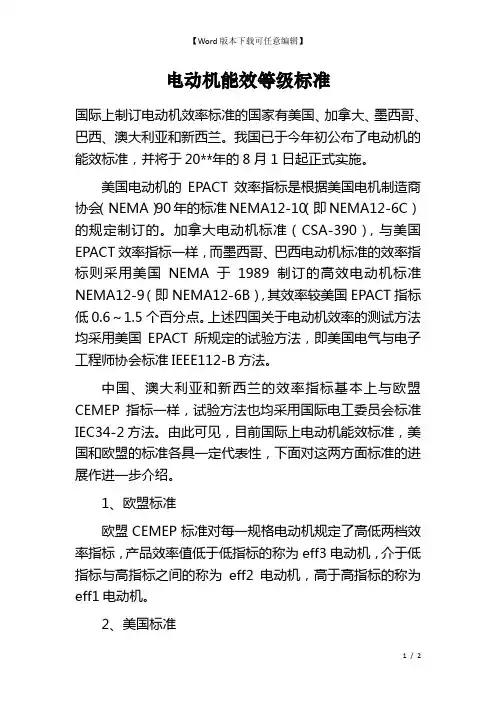
电动机能效等级标准国际上制订电动机效率标准的国家有美国、加拿大、墨西哥、巴西、澳大利亚和新西兰。
我国已于今年初公布了电动机的能效标准,并将于20**年的8月1日起正式实施。
美国电动机的EPACT效率指标是根据美国电机制造商协会(NEMA)90年的标准NEMA12-10(即NEMA12-6C)的规定制订的。
加拿大电动机标准(CSA-390),与美国EPACT效率指标一样,而墨西哥、巴西电动机标准的效率指标则采用美国NEMA于1989制订的高效电动机标准NEMA12-9(即NEMA12-6B),其效率较美国EPACT指标低0.6~1.5个百分点。
上述四国关于电动机效率的测试方法均采用美国EPACT所规定的试验方法,即美国电气与电子工程师协会标准IEEE112-B方法。
中国、澳大利亚和新西兰的效率指标基本上与欧盟CEMEP指标一样,试验方法也均采用国际电工委员会标准IEC34-2方法。
由此可见,目前国际上电动机能效标准,美国和欧盟的标准各具一定代表性,下面对这两方面标准的进展作进一步介绍。
1、欧盟标准欧盟CEMEP标准对每一规格电动机规定了高低两档效率指标,产品效率值低于低指标的称为eff3电动机,介于低指标与高指标之间的称为eff2电动机,高于高指标的称为eff1电动机。
2、美国标准美国NEMA在制订了效率标准NEMA12-10以后,考虑到对更高效率水平的需求,又制订了NEMA E设计标准,即NEMA12-11标准,其效率指标较NEMA12-10提高了1~4个百分点,但其起动性能则有所降低。
近年来,由于美国电力供给又趋紧张,由美国各州电力公司为主组成的能源效率联盟(CEE)与美国NEMA联合制订了起动性能与EPACT要求一致的超高效率电机(Premium Efficiency)指标,其效率水平接近NEMA E设计,较EPACT指标提高了1~3个百分点,损耗又较EPACT下降了20%左右。
由于我国电源频率、功率与尺寸计量的标准以及电动机的功率等级及安装尺寸的关系均与欧州一样,同时我国对于电动机的基本技术要求和试验方法等标准也和欧洲一样符合IEC标准,再考虑到我国电动机的出口量目前已达相当数量,其中3/4是销往欧洲和亚太地区,仅有1/4销往北美地区,因此我国电动机能效标准以欧洲CEMEP低档值作为最低能效限值,即在国内生产和进口的电动机均要到达此指标,而以CEMEP高档值作为节能评价值,即到达或超过此指标的电动机才可称为高效率电动机或节能电动机。
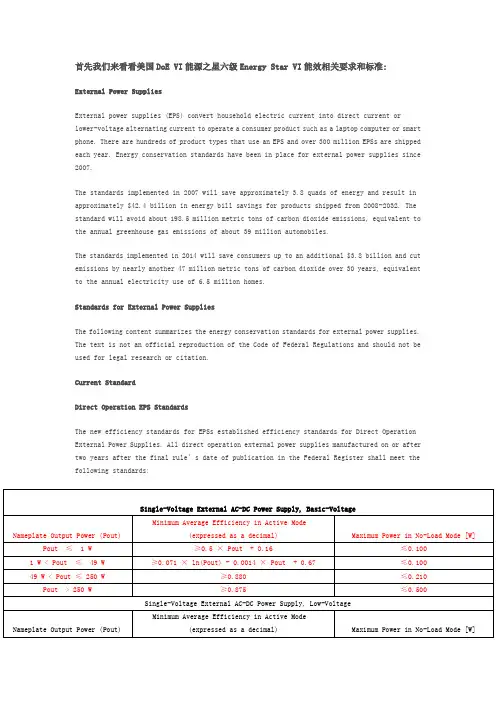
首先我们来看看美国DoE VI能源之星六级Energy Star VI能效相关要求和标准:External Power SuppliesExternal power supplies (EPS) convert household electric current into direct current or lower-voltage alternating current to operate a consumer product such as a laptop computer or smart phone. There are hundreds of product types that use an EPS and over 300 million EPSs are shipped each year. Energy conservation standards have been in place for external power supplies since 2007.The standards implemented in 2007 will save approximately 3.8 quads of energy and result in approximately $42.4 billion in energy bill savings for products shipped from 2008-2032. The standard will avoid about 198.5 million metric tons of carbon dioxide emissions, equivalent to the annual greenhouse gas emissions of about 39 million automobiles.The standards implemented in 2014 will save consumers up to an additional $3.8 billion and cut emissions by nearly another 47 million metric tons of carbon dioxide over 30 years, equivalent to the annual electricity use of 6.5 million homes.Standards for External Power SuppliesThe following content summarizes the energy conservation standards for external power supplies. The text is not an official reproduction of the Code of Federal Regulations and should not be used for legal research or citation.Current StandardDirect Operation EPS StandardsThe new efficiency standards for EPSs established efficiency standards for Direct Operation External Power Supplies. All direct operation external power supplies manufactured on or after two years after the final rule’s date of publication in the Federal Register shall meet the following standards:下面我们在看看欧盟CoC V5六级能效标准与要求的原文节选AIMTo minimise energy consumption of external power supplies both under no-load and load conditions in the output power range 0.3W to 250W.COMMITMENTSignatories of this Code of Conduct commit themselves to:Design power supplies or component so as to minimise energy consumption of external power supplies. Those companies who are not responsible for the production of power supplies shall include the concept of minimisation of energy consumption in their purchasing procedures of power supplies.Achieve both the no-load power consumption and on-mode efficiency targets shown in Table 1.1, Table 2.1 and 2.2 for at least 90% of products2, for the new models of external power supplies that are introduced on the market or specified in a tender/procurement after the effective date (for new participants after the date they have signed the Code of conduct).Table 1.1: No-load Power ConsumptionTable 2.1: Energy-Efficiency Criteria for Active Mode (excluding Low Voltage external power supplies)。


开关电源六级能效详解(总3页)-CAL-FENGHAL-(YICAI)-Company One 1■CAL-本页仅作为文档封面.使用请直接删除开关电源高级能效详解近一两年内,基本做电源产品都为了更新六级能效而忙碌,新规要求倒逼产品升级换代,是好事,也是挑战。
关于六级能效,两个要求:一,待机功耗二,平均效率针对这两点,除了拥有一颗新颖的IC,还有那些细工需要注意的,扒一扒。
首先,先了解下标准要求:美国能效要求一、待机功耗以美国能效要求为例,要求49W以下空载功耗为0.1W,大于49W空载功耗为0. 21W;欧盟49W以下为75mW,大于49W为150mW o在设计电源时,相对于75mW的空载功耗,必须要精打细算到每个细节上。
以下儿点为显在的固定消耗点:1,Vcc启动回路2,X电容放电回路3,IC Vcc供电回路4,电压(电流)检测环路5,假负载首先,新出的IC大多具有HV启动关断功能,启动后关闭启动电阻回路,避免此回路损耗。
当然,这属于IC原有功能,不在本贴的主旨中,这里一带过,同时后面的一些延伸也会用到此引脚,顺带一说。
如下:当没有HV启动功能的芯片时,Vcc只能尽量大启动电阻,大的启动电阻乂需要较快的启动时间时,可以这样做,Vcc两级DC接法,C16用于启动储能,C14用于辅助供电储能,使启动时较大R的情况下C能更快充到IC启动阈值:X电容放电IEC60950要求1S内电压下降到37%IEC60065要求2S内电压下降到35V以下例,按第1条,X电容放电时间常数RC需小于1,设X电容为0. 33uF, Rx<x<l,那么Rx<3MQ,由于电容量存在20%误差,那么此电阻选值留足裕量,那应在Rx>:<0. 7内,约2MQ。
电阻损耗,PR二U2/R,设ACmax=264VPR二2642/2MPR二34. 8mWCoC要求49W以下73mW待机或DoE要求49W以下100mW待机,不管那个标准,这部份的损耗都显得巨大。
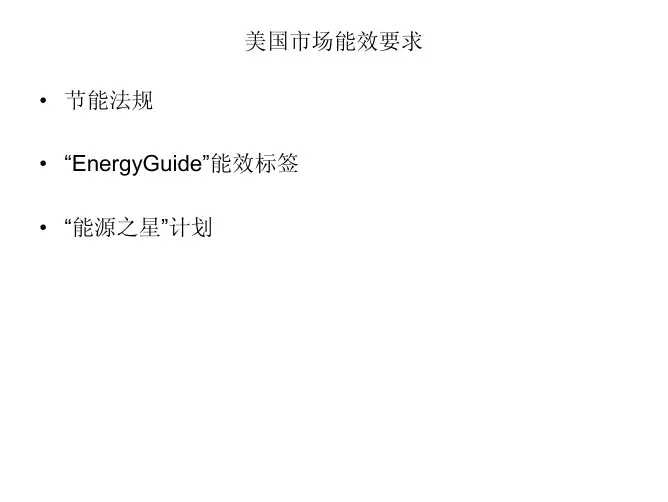

Table 1: Energy-Efficiency Criteria for Ac-Ac and Ac-Dc External Power Suppliesin Active Mode: Standard Models (普通机型)Nameplate Output Power (Pno)0 to ≤ 1 watt > 1 to ≤ 49 watts > 49 wattsTable 2: Energy-Efficiency Criteria for Ac-Ac anin Active Mode: Low Voltage Models (低电压机型) 电压≤6V并且电流≥550mANameplate Output Power (Pno)0 to ≤ 1 watt> 1 to ≤ 49 watts > 49 wattsTable 4: Energy Consumption Criteria for No-Lo(空载功耗)0 to < 50 watts ≥ 50 to ≤ 250 watts另外对于输入功率大于或等于100W 的外部电源还要求功率因素必需大于或等于0.9(能效等级4 空载功耗.0标准Nameplate Output Power (Pno)(能效等级4).0标准a for Ac-Ac and Ac-Dc External Power Supplies(普通机型)Minimum Average Efficiency in Active Mode (expressed as adecimal) 2≥ 0.480 * P no + 0.1400.8446≥ [0.0626 * Ln (P no )] + 0.6220.71≥ 0.870Ac and Ac-Dc External Power Suppliesodels (低电压机型) 电压≤6V并且电流≥550mAMinimum Average Efficiency in Active Mode (expressed as adecimal) 2≥ 0.497 * P no + 0.067≥ [0.0750 * Ln (P no )] + 0.5610.704216≥ 0.860Pno 是铭牌上标的功率No-Load (空载功耗)Ac-Ac EPSAc-Dc EPS ≤ 0.5 watts ≤ 0.3watts ≤ 0.5 watts≤ 0.5watts的外部电源还要求功率因素必需大于或等于0.9Maximum Power in No-Load牌上标的功率。
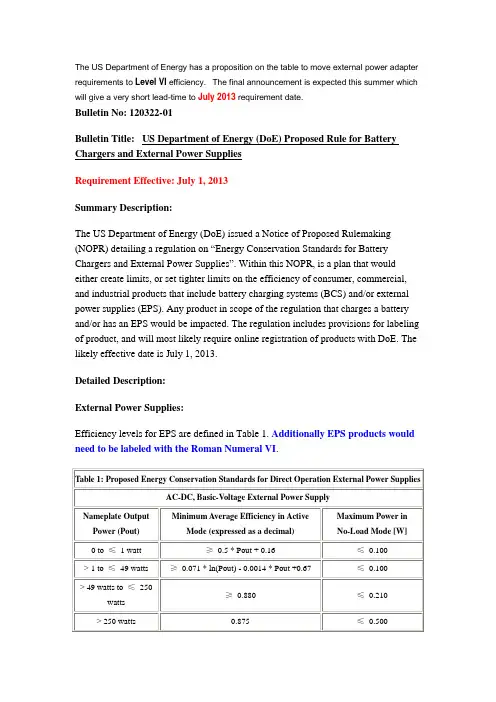
The US Department of Energy has a proposition on the table to move external power adapter requirements to Level VI efficiency. The final announcement is expected this summer which will give a very short lead-time to July 2013 requirement date.Bulletin No: 120322-01Bulletin Title:US Department of Energy (DoE) Proposed Rule for Battery Chargers and External Power SuppliesRequirement Effective:July 1, 2013Summary Description:The US Department of Energy (DoE) issued a Notice of Proposed Rulemaking (NOPR) detailing a regulation on “Energy Conservation Standards for Battery Chargers and External Power Supplies”. Within this NOPR, is a plan that would either create limits, or set tighter limits on the efficiency of consumer, commercial, and industrial products that include battery charging systems (BCS) and/or external power supplies (EPS). Any product in scope of the regulation that charges a battery and/or has an EPS would be impacted. The regulation includes provisions for labeling of product, and will most likely require online registration of products with DoE. The likely effective date is July 1, 2013.Detailed Description:External Power Supplies:Efficiency levels for EPS are defined in Table 1. Additionally EPS products would need to be labeled with the Roman Numeral VI.Table 1: Proposed Energy Conservation Standards for Direct Operation External Power SuppliesAC-DC, Basic-Voltage External Power SupplyNameplate Output Power (Pout)Minimum Average Efficiency in ActiveMode (expressed as a decimal)Maximum Power inNo-Load Mode [W]0 to ≤ 1 watt≥0.5 * Pout + 0.16≤ 0.100 > 1 to ≤ 49 watts≥0.071 * ln(Pout) - 0.0014 * Pout +0.67≤ 0.100 > 49 watts to ≤ 250watts≥ 0.880≤ 0.210 > 250 watts0.875≤ 0.500AC-DC, Low-Voltage (<6V) External Power SupplyNameplate Output Power (Pout)Minimum Average Efficiency in ActiveMode (expressed as a decimal)Maximum Power inNo-Load Mode [W]0 to ≤ 1 watt≥0.517 * Pout + 0.087≤ 0.100 > 1 to ≤ 49 watts≥0.0834 * ln(Pout) - 0.0014 * Pout + 0.609≤ 0.100 > 49 watts to ≤ 250watts≥ 0.870≤ 0.210 > 250 watts0.875≤ 0.500AC-AC, Basic-Voltage External Power SupplyNameplate Output Power (Pout)Minimum Average Efficiency in ActiveMode (expressed as a decimal)Maximum Power inNo-Load Mode [W]0 to ≤ 1 watt≥0.5 * Pout + 0.16≤ 0.210 > 1 to ≤ 49 watts≥0.071 * ln(Pout) - 0.0014 * Pout +0.67≤ 0.210 > 49 watts to ≤ 250watts≥ 0.880≤ 0.210 > 250 watts0.875≤ 0.500 AC-AC, Low-Voltage (<6V) External Power SupplyNameplate Output Power (Pout)Minimum Average Efficiency in ActiveMode (expressed as a decimal)Maximum Power inNo-Load Mode [W]0 to ≤ 1 watt≥0.517 * Pout + 0.087≤ 0.210 > 1 to ≤ 49 watts≥0.0834 * ln(Pout) - 0.0014 * Pout + 0.609≤ 0.210 > 49 watts to ≤ 250watts≥ 0.870≤ 0.210 > 250 watts0.875≤ 0.500Multiple-Voltage External Power SupplyNameplate Output Power (Pout)Minimum Average Efficiency in ActiveMode (expressed as a decimal)Maximum Power inNo-Load Mode [W]0 to ≤ 1 watt≥ 0.497 ×Pout + 0.067≤ 0.300> 1 to ≤ 49 watts≥ 0.075 ×ln (Pout) + 0.561≤ 0.300 > 49 watts ≥ 0.860≤ 0.300Battery Chargers:Battery Chargers are classified in Table 2. Table 2 also shows the regulated Unit Energy Consumption (UEC) for each product class.Table 2. Proposed Energy Conservation Standards for Battery ChargersProduct Class #Input /OutputTypeBatteryEnergy(Wh)Special Characteristic orBattery VoltageMaximum UEC***(kWh/yr)1AC In, DCOut < 100Inductive Connection* 3.042< 4 V= 0.2095(Ebatt**) + 5.873 4 – 10 VFor Ebatt < 9.74 Wh,= 4.68For Ebatt ≥ 9.74 Wh, = 0.0933(Ebatt) + 3.774> 10 VFor Ebatt < 9.71 Wh,= 9.03For Ebatt ≥ 9.71 Wh, = 0.2411(Ebatt) + 6.695100–3000< 20 VFor Ebatt < 355.18 Wh,= 20.06For Ebatt ≥ 355.18 Wh,= 0.0219(Ebatt) + 12.286≥ 20 VFor Ebatt < 239.48 Wh= 30.37For Ebatt ≥ 239.48 Wh = 0.0495(Ebatt) + 18.517> 3000-= 0.502(Ebatt) + 4.538DC In, DCOut -< 9 V Input0.669-≥ 9 V Input No Standard10a AC In, ACOut-Basic (i.e. no AutomaticV oltage Regulation)For Ebatt < 37.2 Wh, = 2.54For Ebatt ≥ 37.2 Wh, =0.0733(Ebatt) – 0.1810b-Contains Automatic V oltageRegulationFor Ebatt < 37.2 Wh, = 6.18For Ebatt ≥ 37.2 Wh, =0.0733(Ebatt) + 3.4511AC In, DCOut< 100 WhWireless Charging Capability(for dry environments)Reserved* Inductive connection and designed for use in a wet environment (e.g. electric toothbrushes)**Ebatt = Measured battery energy as determined in section 5.6 of Appendix Y to Subpart B of Part 430.***UEC can be determined using the information in the ANNEX of this bulletin.。
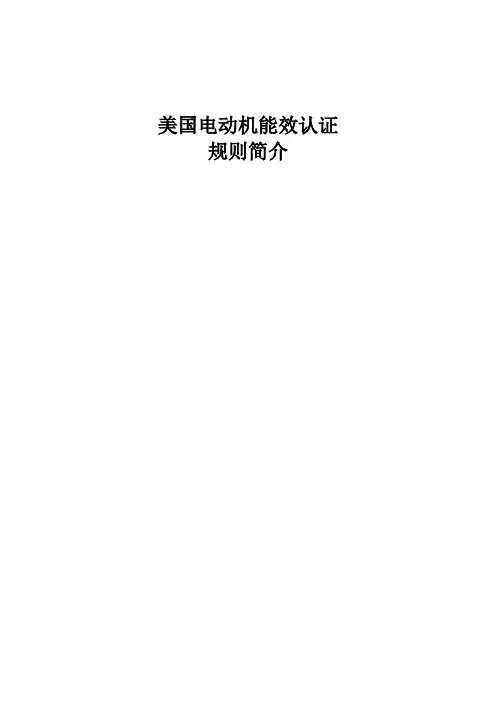
美国电动机能效认证规则简介目次1.能效认证电动机的范围2.能效标准与试验方法2.1能效标准2.2能效测试方法2.3能效确定2.4记录保存3.标记4.市场监督4.1被禁止的行为4.2对违禁行为的处罚5.强制检验5.1试验通知5.2试验室5.3抽样5.4试验电机的选择5.5试验电动机的预备附录A.名义效率表附录B.强制试验抽样方案美国能源部(DOE)于1999年10月5日在联邦纪事(Federal Register)上公布了《10CFR第431部分某些商业和工业设备能效项目:电动机试验程序、标记和认证要求的最终规则》,此认证规则于1999年11月4日生效。
电动机的效率经认证符合能效标准方可在美国销售,因而电动机能效认证是市场准入认证,是强制性认证。
电动机符合能效标准的认证称符合认证(Compliance Certification),简称CC认证。
经认证符合能效标准的电动机由美国能源部发给CC号,即“CC××××”,此CC号标示在电动机的铭牌上和电动机的营销资料中。
需要能效认证的电动机,以下简称为能效电动机。
本文主要介绍能效电动机的范围、能效标准和试验方法、标记和有关市场监督方面的内容。
1. 能效认证电动机范围1.1 电动机的定义能源部认证规则中电动机的法定定义如下:(1)电动机是指将电能转换为机械能的机器,是指:(ⅰ)通用电动机,包括但不限于具有防爆结构的电动机;(ⅱ)单速感应电动机(MG1-1993,1.16.1,又见MG1-2003,1.18.1);(ⅲ) 连续定额(MG1-1993,1.40.1,又见MG1-2003,1.40.1);(ⅳ)笼型转子(MG1-1993,1.16.1.1,又见MG1-2003,1.18.1.1),底脚安装,包括带凸缘的底脚安装和可拆卸底脚安装;(ⅴ)按NEMA T机座尺寸制造(MG1-1993:4.01,图4-1,4-2,4-3和4-4;又见MG1-2003:4.1及图4-1,4-2,4-3和4-4。
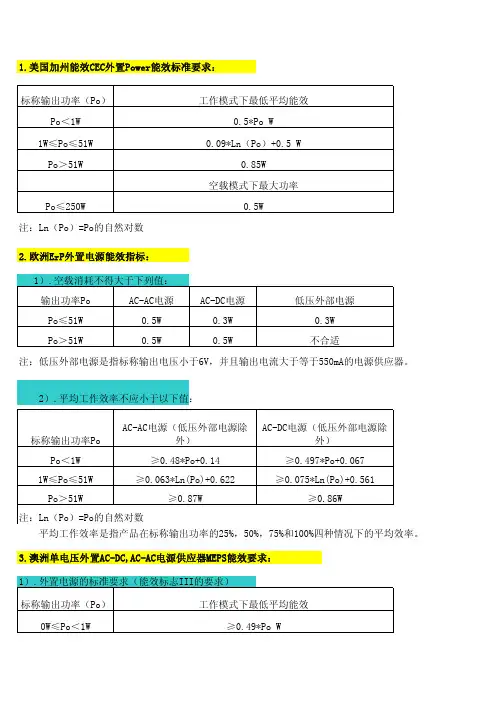
AC-AC电源AC-DC电源0.5W 0.3W 0.5W0.5WAC-AC电源(低压外部电源除外)≥0.48*Po+0.14≥0.49*Po W≥0.87WAC-DC电源(低压外部电源除外)≥0.497*Po+0.067≥0.86W工作模式下最低平均能效0.5*Po W 0.09*Ln(Po)+0.5 W0.85W空载模式下最大功率0.5W工作模式下最低平均能效≥0.075*Ln(Po)+0.561低压外部电源0.3W 不合适≥0.063*Ln(Po)+0.6221.美国加州能效CEC外置Power能效标准要求:标称输出功率(Po)Po<1W 1W≤Po≤51W Po>51WPo≤250W注:Ln(Po)=Po的自然对数2.欧洲ErP外置电源能效指标: 1).空载消耗不得大于下列值:输出功率Po Po≤51W Po>51W注:低压外部电源是指标称输出电压小于6V,并且输出电流大于等于550mA的电源供应器。
2).平均工作效率不应小于以下值:标称输出功率PoPo<1W 1W≤Po≤51W Po>51W注:Ln(Po)=Po的自然对数平均工作效率是指产品在标称输出功率的25%,50%,75%和100%四种情况下的平均效率。
3.澳洲单电压外置AC-DC,AC-AC电源供应器MEPS能效要求:1).外置电源的标准要求(能效标志III的要求)标称输出功率(Po)0W≤Po<1W≥0.09*Ln(Po)+0.5 W≥0.09*Ln(Po)+0.49 W≥0.84W 工作模式下最低平均能效≥0.5*Po W 无要求空载模式下最大功率≤0.75WAC-DCAC-AC ≤0.5W 无要求≥0.85W 空载模式下最大功率AC-DCAC-AC ≤0.5W无要求对数工作模式下最低平均能效≥0.497*Po W+0.067≥0.0626*Ln(Po)+0.622 W≥0.87W≥0.075*Ln(Po)+0.561 W≥0.86W工作模式下最低平均能效≥0.480*Po W+0.141W≤Po≤49W 49W<Po≤250W0W≤Po≤10W 10W<Po≤250W注:Ln(Po)=Po的自然对数2.外置电源最高能效要求(能效表示Ⅳ要求)标称输出功率(Po)0W≤Po<1W 1W≤Po≤51W 51W<Po≤250W0W≤Po≤250W注:Ln(Po)=Po的自然3.外置电源最高能效要求(能效表示Ⅴ要求)输出电压小于6V,输出电流大于等于0.55mA,要求如下:标称输出功率(Po)0W≤Po<1W 1W≤Po≤49W 49W<Po≤250W除输出电压小于6V,输出电流大于等于0.55mA之外的要求如下:标称输出功率(Po)0W≤Po<1W 1W≤Po≤49W 49W<Po≤250W。
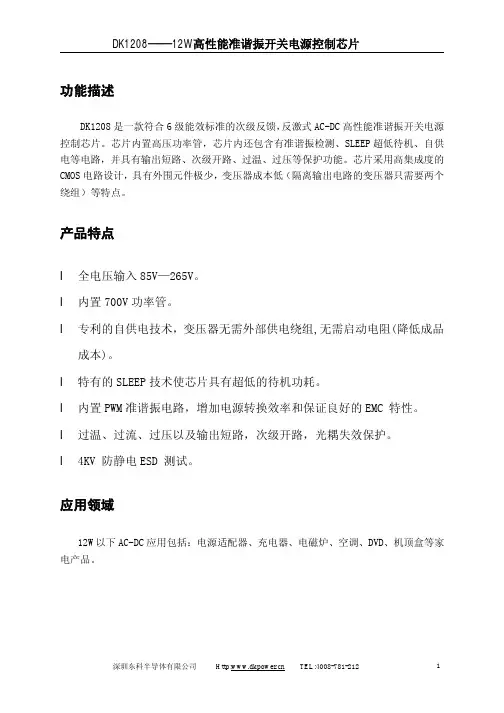

开关电源六级能效详解 Prepared on 22 November 2020开关电源高级能效详解近一两年内,基本做电源产品都为了更新六级能效而忙碌,新规要求倒逼产品升级换代,是好事,也是挑战。
关于六级能效,两个要求:一,待机功耗二,平均效率针对这两点,除了拥有一颗新颖的IC,还有那些细工需要注意的,扒一扒。
首先,先了解下标准要求:美国能效要求一、待机功耗以美国能效要求为例,要求49W以下空载功耗为,大于49W空载功耗为;欧盟49W以下为75mW,大于49W为150mW。
在设计电源时,相对于75mW的空载功耗,必须要精打细算到每个细节上。
以下几点为显在的固定消耗点:1,Vcc启动回路2,X电容放电回路3,ICVcc供电回路4,电压(电流)检测环路5,假负载首先,新出的IC大多具有HV启动关断功能,启动后关闭启动电阻回路,避免此回路损耗。
当然,这属于IC原有功能,不在本贴的主旨中,这里一带过,同时后面的一些延伸也会用到此引脚,顺带一说。
如下:当没有HV启动功能的芯片时,Vcc只能尽量大启动电阻,大的启动电阻又需要较快的启动时间时,可以这样做,Vcc两级DC接法,C16用于启动储能,C14用于辅助供电储能,使启动时较大R的情况下C能更快充到IC启动阈值:X电容放电IEC60950要求1S内电压下降到37%IEC60065要求2S内电压下降到35V以下例,按第1条,X电容放电时间常数RC需小于1,设X电容为,Rx*Cx<1,那么Rx<3MΩ,由于电容量存在20%误差,那么此电阻选值留足裕量,那应在Rx*内,约2MΩ。
电阻损耗,PR=U2/R,设ACmax=264VPR=2642/2MPR=CoC要求49W以下75mW待机或DoE要求49W以下100mW待机,不管那个标准,这部份的损耗都显得巨大。
怎么办,使用更小的X电容(当以下,可以不使用放电电阻),或想办法让这个R更灵活一点,如下:1,在断电后,利用IC的HV脚对Cx进行放电2,没有HV启动脚,将启动电阻接到X电容放电电阻中点,断电后,利用IC的Vcc脚帮助放电,可减小X电容两端电阻的放电功率:3,把EMC元件后移动,AC端不放X电容:Vcc供电尽量小的Vcc限流电阻,减小损耗。
DOE外置电源(EPS)能效新要求2014年2月10号,美国能源部(DOE)颁布了外置电源(EPS)能效新要求的最终法案。
新的外置电源能效法案将适用于所有的直接使用型外置电源,还包括2007年颁布的class A外置电源。
此次颁布的新的外置电源能效法案扩大了产品范围,如多电压输出类型外置电源,输出功率大于250W的外置电源都在产品要求范围内。
新颁布的EPS能效要求新版名称为直接使用型外置电源能效标准(Direct Operation External Power Supply Efficiency Standards)。
该法案将在其被记入联邦记事两年后正式生效。
在我们了解新的EPS能效要求前,先熟悉几个名词定义:单电压AC-DC外置电源:将线电压AC转为低电压DC输出的,并且一次只能转换一个DC输出的外置电源。
单电压AC-AC外置电源:将线电压AC转为低电压AC输出的,并且一次只能转换一个AC输出的外置电源。
多电压外置电源:将线电压AC同时转换为2个甚至多个低电压输出的外置电源。
低电压外置电源:标称输出电压低于6V,输出电流大于等于550mA的外置电源。
基本电压外置电源:非低电压外置电源。
直接使用型外置电源:不通过电池的帮助,能直接使用于消费品的外置电源,非电池充电器。
如下表格为直接使用型外置电源能效标准要求:关于豁免:以下两种情况的外置电源不需要满足新版外置电源能效要求;1 .用于在联邦食品药品管理局listing的医疗设备的外置电源2 .标称输出电压小于3V,电流大于等于1000mA的AC-DC外置电源,或是主要用于马达设备的电池充电器等。
此次颁布的美国EPS能效要求其对应的能效标识为“VI”级,它的强制执行日期是在该法令纳入联邦记事之后两年即2016年,而之前的美国EPS 能效要求Class A External Power Supply Efficiency Standards, 其对应的能效标识为“IV”级,目前仍然保留,在美国仍然有效,因此现阶段客户生产的EPS并没有强制要求满足新版能效要求,但是能提前符合新版能效要求最好,所以客户可以提前做好准备。
什么是六级能效标准
六级能效标准是指一种能源效率评价标准,通常用于评估和比较电器、设备或
建筑物的能源利用效率。
这一标准是为了鼓励节能减排、提高能源利用效率,从而降低能源消耗和环境污染而设立的。
六级能效标准通常包括了能源消耗、能源利用效率、环境友好性等方面的要求。
对于不同类型的产品或建筑物,六级能效标准会有所不同,但总的目标都是为了提高能源利用效率,减少能源浪费和环境污染。
在实际应用中,六级能效标准往往会影响到产品的设计、生产和销售。
符合六
级能效标准的产品通常会受到政府的认可和奖励,也更受消费者的青睐。
因此,对于生产企业来说,遵守六级能效标准不仅是一种法律要求,也是一种市场需求和竞争优势。
同时,六级能效标准也对消费者和用户产生了一定的影响。
在购买电器、设备
或建筑材料时,消费者可以通过查看产品的能效标识来选择更节能环保的产品,从而为节能减排做出贡献。
在全球范围内,各国都在积极推动六级能效标准的制定和实施。
通过建立和完
善六级能效标准体系,不仅可以提高产品和建筑物的能源利用效率,也可以推动相关产业的发展和升级,促进经济的可持续发展。
总的来说,六级能效标准是一种重要的能源管理工具,它不仅可以引导企业生
产更节能环保的产品,也可以引导消费者选择更节能环保的产品,从而共同为实现可持续发展和环保目标做出贡献。
希望各界能够共同努力,推动六级能效标准的落实和推广,共同建设一个更加节能环保的社会和环境。
LED灯泡与灯具的欧美能效要求1.欧洲能效要求欧洲的能效要求主要是以欧盟的ErP的要求为代表。
ErP指令和LVD指令、EMC指令一样,也被纳入欧盟的CE体系里。
因此相关涉及产品都要符合ErP要求后才能在产品铭牌上标注CE标志并有指定机构负责市场监督,是欧盟的强制执行的要求。
在照明产品方面,自2009年欧盟推出了针对非定向光源(主要是卤素灯,荧光节能灯)的EC244/2009和针对荧光灯管、镇流器以及据此组成的灯具的EC245/2009后,在2012年12月又推出了针对所有LED灯泡和定向光源的EU1194/2012,以下我们着重对LED照明产品相关要求做个简要的介绍。
首先它分了三个阶段来实现这个要求,第一阶段是2013年9月1号,第二阶段是2014年9月1号,第三阶段是2016年9月1号。
它要求符合EU1194范围的光源包括LED光源都要满足下列EEI的要求:另外所有LED光源和LED灯具都要满足下列测试要求:按照规定,每项测试要求都要求是20个样品取平均值和表格中要求做判断。
整个测试周期至少6000小时。
2. 美国能效要求美国目前的LED灯泡和灯具的能效要求主要集中在LED灯具的Lighting Facts label、能源之星和DLC,他们都属于自愿性的要求;另外在美国加州,对可移动式LED灯具需要满足加州能耗的特别要求,这个属于强制性的要求。
下面分别说明:(1) Lighting Facts label的能效要求它是美国能源部(DoE)宣布实施的能效标签,目前只针对LED灯具产品,它推出的本意是“Give them the Facts”,是为了让照明产品达到数据更具体和可信度更高的要求,从五个方面告诉客户该产品真实的性能参数:初始流明lm、初始光效lm/W、输入功率W、相关色温CCT、显色性指数CRI。
从2012年10月颁布的lighting facts要求中又新增了两个可选指标,分别为“质量保证”和基于LM-80以及TM-21测试所获得的“流明维持率”指标。
开关电源高级能效详解近一两年内,基本做电源产品都为了更新六级能效而忙碌,新规要求倒逼产品升级换代,是好事,也是挑战。
关于六级能效,两个要求:一,待机功耗二,平均效率针对这两点,除了拥有一颗新颖的IC,还有那些细工需要注意的,扒一扒。
首先,先了解下标准要求:美国能效要求一、待机功耗以美国能效要求为例,要求49W以下空载功耗为0.1W,大于49W空载功耗为0.21W;欧盟49W 以下为75mW,大于49W为150mW。
在设计电源时,相对于75mW的空载功耗,必须要精打细算到每个细节上。
以下几点为显在的固定消耗点:1,Vcc启动回路2,X电容放电回路3,IC Vcc供电回路4,电压(电流)检测环路5,假负载首先,新出的IC大多具有HV启动关断功能,启动后关闭启动电阻回路,避免此回路损耗。
当然,这属于IC原有功能,不在本贴的主旨中,这里一带过,同时后面的一些延伸也会用到此引脚,顺带一说。
如下:当没有HV启动功能的芯片时,Vcc只能尽量大启动电阻,大的启动电阻又需要较快的启动时间时,可以这样做,Vcc两级DC接法,C16用于启动储能,C14用于辅助供电储能,使启动时较大R的情况下C能更快充到IC启动阈值:X电容放电IEC60950要求1S内电压下降到37%IEC60065要求2S内电压下降到35V以下例,按第1条,X电容放电时间常数RC需小于1,设X电容为0.33uF,Rx*Cx<1,那么Rx<3MΩ,由于电容量存在20%误差,那么此电阻选值留足裕量,那应在Rx*0.7内,约2MΩ。
电阻损耗,PR=U2/R,设ACmax=264VPR=2642/2MPR=34.8mWCoC要求49W以下75mW待机或DoE要求49W以下100mW待机,不管那个标准,这部份的损耗都显得巨大。
怎么办,使用更小的X电容(当0.1uF以下,可以不使用放电电阻),或想办法让这个R更灵活一点,如下:1,在断电后,利用IC的HV脚对Cx进行放电2,没有HV启动脚,将启动电阻接到X电容放电电阻中点,断电后,利用IC的Vcc脚帮助放电,可减小X 电容两端电阻的放电功率:3,把EMC元件后移动,AC端不放X电容:Vcc供电用限流电阻,较小的电压标测环流,如图流经R11、R16的静态电流。